 |
||
|
||
| ||
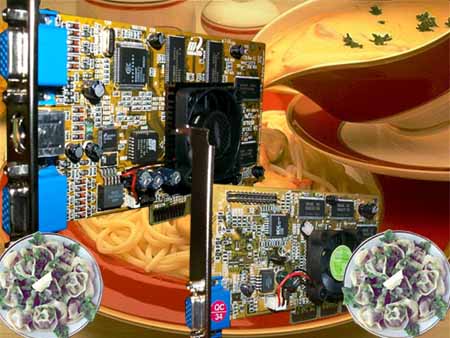 You all know that the limiting factor for the NVIDIA GeForce2 MX is a low bandwidth of the local memory. If you add to those 32 MBytes another portion of 32 MBytes it will hardly help a player. The better solution is an installation of a faster memory. So, today we are going to compare the NVIDIA GeForce2 MX based card with 64 MBytes of the memory that is inefficient for such chipset with a usual card on the same chipset but with 32 MBytes of video memory. Nevertheless, the NVIDIA GeForce2 MX cards with 64 MBytes memory start pouring onto the shelves. Taking into consideration the experience gained with the NVIDIA GeForce256 SDR based cards equipped with the same memory size we can state that the idea will fail. However, there is one great difference. The price for the GeForce2 MX cards which are improved such a way won't differ from the price for the 32 MBytes variant because of an installation of the cheaper memory. Not so long ago some video card manufacturers including Innovision Multimedia have announced the modified models of the GeForce2 MX cards with 64 MBytes memory. Innovision, following the tradition of extension of their range of video cards from the NVIDIA GeForce2 MX family, was almost the first who introduced their 64-MB solution. Let's take a gander at this card. BoardThe Inno3D Tornado GeForce2 MX 64 MBytes Twinview card has AGP x2/x4 interface, 64 MBytes SDR SDRAM memory located in 8 chips on the right and back sides of the PCB. 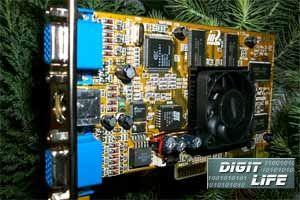 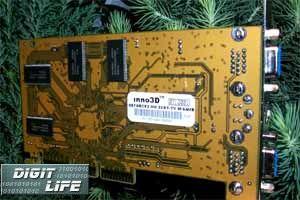  The memory chips are produced by Hyundai, the T-H marking says that it's 133-MHz chips. It implies that the access time is 7.5 ns. The memory works at the rated 166 MHz. It means that it makes no sense to overclock the memory since it was already overclocked by the manufacturer, and the experience says that without an increase of the memory clock it's useless to overclock the GPU. The card's design is very similar to that of the PCI-model of the GeForce2 MX series from Innovision. Nevertheless, there is some difference. First of all, they are connected with a presence of the VGA connectors what means the TwinView support. On the right side of the PCB there is a chip of the second RAMDAC. In layout the board greatly differs from the reference design, even though some elements correspond to the latter, in particular, TV-out is located between two VGA-connectors. The TV-out is equipped with a S-Video output but the box contains an S-Video-to-RCA adapter. The TV-out is supported by TwinView technology thus allowing the simultaneous display of an image on the monitor and on the TV, as well as an extension of the desktop on two signal receivers. The PCB is traditionally yellow, the dimensions are not too huge. The GPU is equipped with a usual cooler with a fan.  The card is shipping in a Retail-package of the typical design. The box contains:
OverclockingThe manufacturers have overclocked the too slow memory themselves thus killing two birds with one stone: they managed to provide the prime cost not higher than that of the earlier released 32 MBytes full value 6 ns memory, plus the marketing campaign will make the video cards with such a huge memory size very attractive proving it by lack of increase in price. So, there is no sense to overclock the card since the only thing we can do is to lift the chipset frequency what yields nothing. Installation and driversThe test system for testing the Inno3D Tornado GeForce2 MX 64 MBytes Twinview:
Since the card is shipped with outdated 6.47 version of NVIDIA drivers we tested on the 7.56. The test were carried out with the VSync disabled on the 6.50 NVIDIA drivers. For comparison we have taken the ATI RADEON 32 MBytes SDR, ATI RADEON LE 32 MBytes DDR, Leadtek WinFast GeForce2 MX/DVI, Leadtek WinFast GeForce2 MX SH Pro cards. Test resultsAs to the 2D quality, I should say that it wasn't disappointing. The quality was at the level of the GeForce2 MX based cards from the top manufacturers. Note that the 2D quality can greatly depend not only on the card manufacturer but also on the definite sample. Besides, check whether your monitor corresponds to the claims you establish for your video card. Now comes the video card performance in 3D. The following programs were used:
Quake3 Arenademo002The test on the standard demo002 was carried out in two modes: Fast (shows card's work in 16-bit color) and High Quality (shows card's work in 32-bit color). 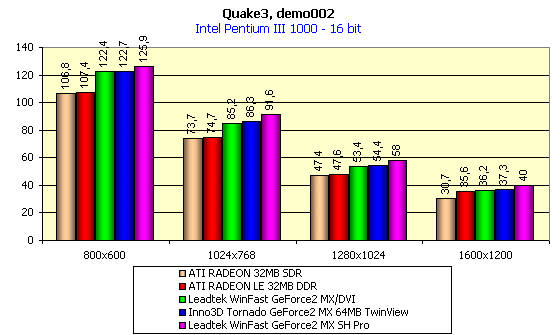 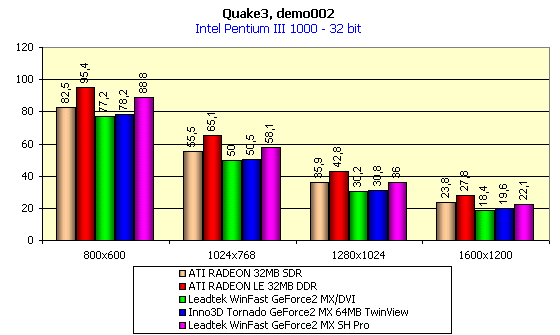 The GeForce2 MX card with 5 ns memory gives higher performance in 3D. The ordinary video card on this GPU with 32 MBytes memory performs not worse than the Inno3D Tornado GeForce2 MX 64 MBytes, plus it has some overclocking potential. And the considering card costs almost the same as the Leadtek WinFast GeForce2 MX SH Pro (and the TwinView support gives advantage to the Inno3D Tornado GeForce2 MX 64 MBytes, however the majority of the users will need only a TV-out). And why 64 MBytes to install? Let's look at the Quaver: QuaverThe tests were carried out in two modes: 16-bit and 32-bit colors at the max possible quality level. 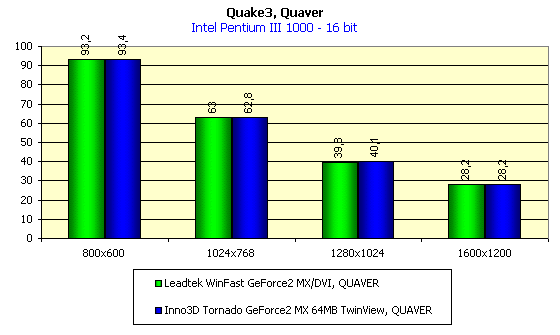 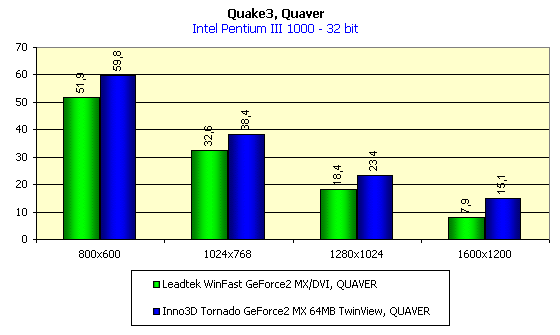 Well, the test shows what gives 64 MBytes memory: there is practically no need in transferring textures of huge size via the AGP-bus, the video card size is quite enough. The gameability corresponds to the appropriate level only at the low resolutions. This possibility of the card under consideration will be in demand only for games with a large volume of textures. ExpendableWe will use this game to show the card's speed in Direct3D. 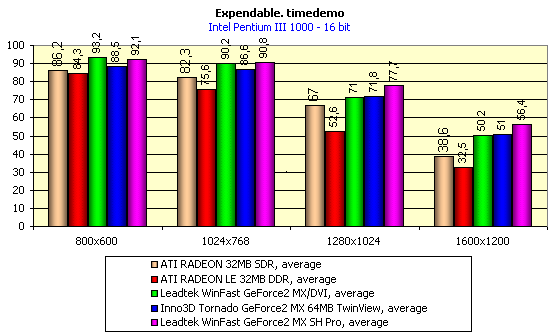 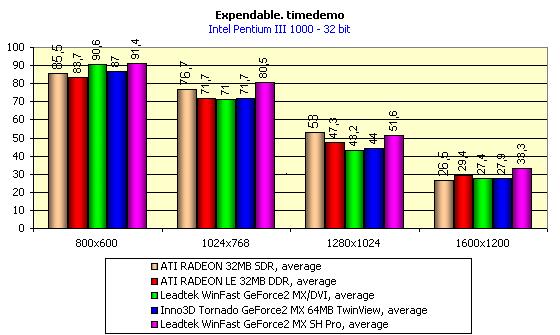 The trend keeps: the card with 32 MBytes of the faster memory greatly outshines the card with the 64 MBytes of the slower memory. Well, the summary on the Inno3D Tornado GeForce2 MX 64 MBytes Twinview performance:
ConclusionThose things which are sacrificed for the sake of a lower price don't justify the production of the card with already overclocked memory. The only advantage of the card is the TwinView. This possibility, though, interest not a wide range of users. We can recommend the Inno3D Tornado GeForce2 MX 64 MBytes TwinView to those of you who need this card for operating at the rated frequency, and to those who need a good TV-out and/or the TwinView. Besides, remember that the card is supplied with an excellent complete set. For thorough comparison characteristics of video cards of this and other classes see our 3Digest. Highs:
Lows:
Write a comment below. No registration needed!
|
Platform · Video · Multimedia · Mobile · Other || About us & Privacy policy · Twitter · Facebook Copyright © Byrds Research & Publishing, Ltd., 1997–2011. All rights reserved. |